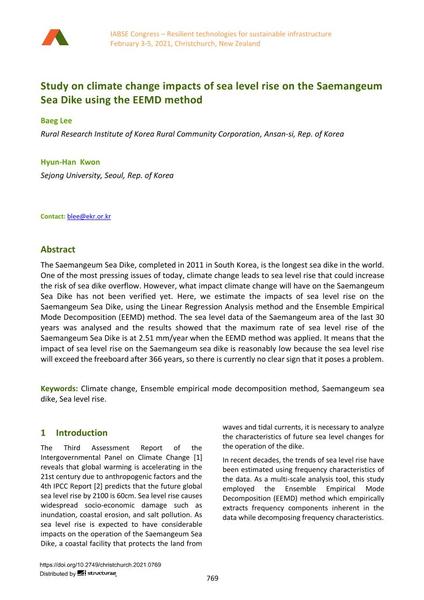Study on climate change impacts of sea level rise on the Saemangeum Sea Dike using the EEMD method

|
|
|||||||||||
Bibliographic Details
| Author(s): |
Baeg Lee
(Rural Research Institute of Korea Rural Community Corporation, Ansan-si, Rep. of Korea)
Hyun-Han Kwon (Sejong University, Seoul, Rep. of Korea) |
||||
|---|---|---|---|---|---|
| Medium: | conference paper | ||||
| Language(s): | English | ||||
| Conference: | IABSE Congress: Resilient technologies for sustainable infrastructure, Christchurch, New Zealand, 3-5 February 2021 | ||||
| Published in: | IABSE Congress Christchurch 2020 | ||||
|
|||||
| Page(s): | 769-774 | ||||
| Total no. of pages: | 6 | ||||
| DOI: | 10.2749/christchurch.2021.0769 | ||||
| Abstract: |
The Saemangeum Sea Dike, completed in 2011 in South Korea, is the longest sea dike in the world. One of the most pressing issues of today, climate change leads to sea level rise that could increase the risk of sea dike overflow. However, what impact climate change will have on the Saemangeum Sea Dike has not been verified yet. Here, we estimate the impacts of sea level rise on the Saemangeum Sea Dike, using the Linear Regression Analysis method and the Ensemble Empirical Mode Decomposition (EEMD) method. The sea level data of the Saemangeum area of the last 30 years was analysed and the results showed that the maximum rate of sea level rise of the Saemangeum Sea Dike is at 2.51 mm/year when the EEMD method was applied. It means that the impact of sea level rise on the Saemangeum sea dike is reasonably low because the sea level rise will exceed the freeboard after 366 years, so there is currently no clear sign that it poses a problem. |
||||
| Keywords: |
climate change Ensemble empirical mode decomposition method Saemangeum sea dike Sea level rise
|
||||
